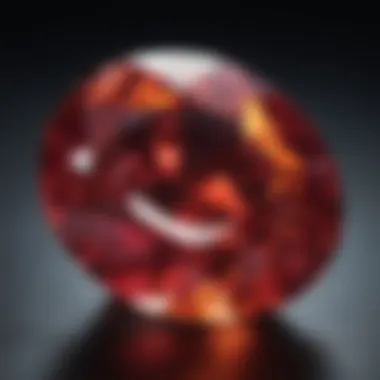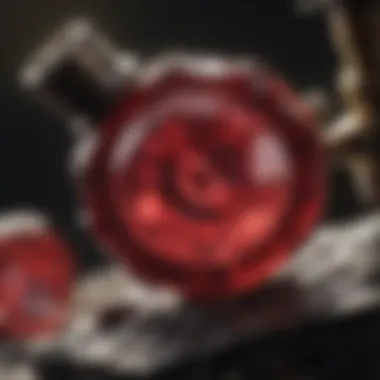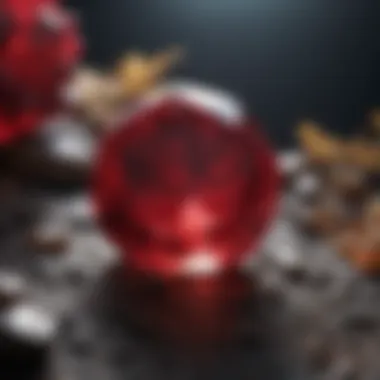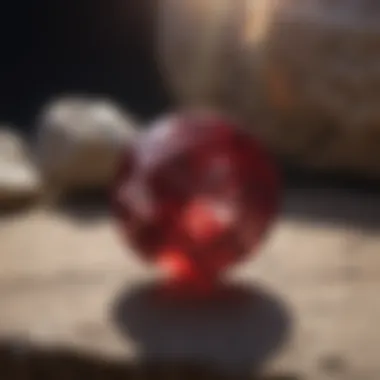A Comprehensive Guide to Identifying Rubies for Rock and Fossil Enthusiasts


Rock and Fossil Identification
As a rock and fossil enthusiast diving into the world of rubies, understanding essential characteristics is paramount. Rubies, part of the corundum family, exhibit a distinct deep red hue due to the presence of chromium. When identifying rubies, observers should pay attention to vivid color saturation, clarity levels, and natural imperfections known as inclusions. These inclusions, such as needle-like rutile crystals or fingerprint-like growth lines, serve as signature markers of authenticity. Additionally, the Mohs scale hardness of 9 places rubies among the hardest gemstones, providing durability for long-term enjoyment. Equipping oneself with a loupe or jeweler's magnifying glass is indispensable for closely inspecting these intricate details.
Collecting Tips and Techniques
For a fruitful collecting experience, enthusiasts should adopt best practices tailored to the unique nature of rubies. Locating prime collecting sites necessitates research into known deposits in regions like Myanmar, Thailand, or Madagascar, where ruby mining thrives. When extracting specimens, caution is advised to prevent damage and ensure safety. Tools like rock hammers, chisels, and brushes aid in the meticulous extraction of rubies from host rocks, preserving their integrity for further examination. Embracing proper extraction techniques and utilizing protective gear will safeguard both the collector and the precious specimens.
Preservation and Display
Preserving rubies post-collection requires a delicate balance between protection and showcase. Techniques such as encapsulating rubies in resin or storing them in padded boxes shield these gems from external elements, preventing scratches or fractures. Proper storage in a cool, dark environment safeguards against color fading and chemical reactions that could alter the gem's composition. For creative display ideas, translucent acrylic stands or velvet-lined cases provide an elegant backdrop, accentuating the vibrant allure of rubies. By embracing preservation methods and thoughtful display strategies, collectors can curate a visually stunning and well-maintained collection.
Geological Insights
Delving into the geological origins of rubies unveils fascinating insights into Earth's dynamic processes. Formed within metamorphic rocks under high pressure and temperature conditions, rubies symbolize the intricate interplay of mineralogy and geology. These gems' historical significance dates back centuries, with civilizations attributing mystical properties and protective qualities to rubies. Notable discoveries in ruby mining, such as the famed Rosser Reeves Star Ruby, showcase the rarity and allure of these gemstones, captivating both collectors and historians alike. By exploring the geological context and historical narratives surrounding rubies, enthusiasts can deepen their appreciation for these mesmerizing geological treasures.
Introduction to Rubies
Rubies are a gemstone coveted for their deep red color and brilliance. In the realm of gemology, rubies hold a special place due to their rarity and exceptional beauty. This section serves as a foundational understanding for enthusiasts delving into the world of rubies, offering crucial insights into their characteristics and significance. Through a detailed examination of rubies, collectors can expand their knowledge and appreciation for these unique gems, unraveling the mysteries that make them a prized possession.
Understanding the Significance of Rubies
Historical Importance
The historical significance of rubies traces back centuries, with cultures across the globe esteeming these gems for their symbolism and mystical properties. Throughout history, rubies have been associated with power, passion, and vitality. Their rich red hue symbolizes love and courage, making them a popular choice for royal jewelry and ceremonial items. Exploring the historical context of rubies provides enthusiasts with a deeper connection to the past, fostering an appreciation for the enduring allure of these gemstones.
Symbolism in Various Cultures
Across diverse cultures, rubies have held different symbolic meanings, reflecting the beliefs and traditions of each society. In some cultures, rubies are associated with prosperity and protection, believed to bring good fortune and ward off evil spirits. The symbolism of rubies in various cultures adds a layer of complexity to their allure, showcasing the universality of their appeal. Understanding the symbolic significance of rubies offers collectors a holistic view of these gemstones, enriching their exploration of their cultural significance.
Key Characteristics of Rubies


Color Intensity
The color intensity of rubies plays a pivotal role in determining their value and attractiveness. A vivid, rich red hue is highly desirable in rubies, with the intensity of the color directly impacting their brilliance and appeal. Collectors often seek rubies with a saturated color that exudes warmth and depth, signifying their quality and rarity. Assessing the color intensity of rubies is essential for enthusiasts looking to acquire valuable and captivating gemstones.
Clarity
The clarity of rubies refers to the presence of any inclusions or imperfections within the gemstone. While some inclusions are natural and do not detract from the beauty of the ruby, excessive flaws can impact its value. Clarity is a crucial factor to consider when evaluating rubies, as a clear and flawless gemstone is highly prized in the world of gemology. Examining the clarity of rubies allows collectors to discern the quality and authenticity of these precious stones.
Cut
The cut of a ruby enhances its brilliance and showcases the gemstone's inherent beauty. A well-executed cut maximizes the ruby's sparkle and ensures that light is refracted in a way that highlights its color and clarity. The precision of the cut determines the overall appeal of the ruby, making it a key characteristic for collectors to assess. Evaluating the cut of rubies enables enthusiasts to appreciate the craftsmanship and artistry involved in shaping these exquisite gems.
Carat Weight
The carat weight of a ruby directly influences its size and overall presence. Larger rubies with a higher carat weight are often more valuable and sought after due to their rarity. However, carat weight is not the sole indicator of a ruby's worth, as other factors like color, clarity, and cut play a significant role in determining its value. Understanding the significance of carat weight allows collectors to prioritize their preferences and make informed decisions when acquiring rubies for their collection.
Natural Vs. Synthetic Rubies
Natural versus synthetic rubies - a crucial topic within the gemstone realm. It forms a pivotal part of this comprehensive guide on identifying rubies, offering valuable insights into the distinctions between these two types. Understanding the nuances between natural and synthetic rubies is paramount for collectors and enthusiasts, influencing value, rarity, and overall appreciation of these precious stones. By delving into this topic, readers can grasp the complexities associated with natural formations versus lab-created versions, enhancing their expertise and discernment in the realm of gemstone identification.
Distinguishing Between Natural and Synthetic Rubies
When it comes to distinguishing between natural and synthetic rubies, visual examination stands out as a fundamental methodology. This technique relies on the naked eye's observations to identify key disparities between natural and lab-created rubies. Visual examination involves scrutinizing the gemstone's inclusions, color consistency, and growth patterns. By honing their visual assessment skills, enthusiasts can detect telltale signs that differentiate natural rubies from their synthetic counterparts. This hands-on approach to evaluation provides a tangible way to appreciate the intricacies of ruby identification.
Visual Examination
Visual examination, a cornerstone in the realm of ruby identification, offers a direct and accessible method for enthusiasts to assess gemstone authenticity. By carefully studying the ruby's internal and external characteristics, such as color saturation, clarity, and any visible flaws, collectors can gather vital clues about its origins. The visual examination process involves inspecting the ruby under proper lighting conditions, utilizing tools like magnifiers to enhance detail visibility. This meticulous scrutiny enables enthusiasts to uncover subtle differences that hint at whether a ruby is natural or synthetic, guiding them towards a more informed decision-making process.
Use of Specialized Equipment
In contrast to visual examination, the use of specialized equipment elevates the precision and depth of ruby authentication. Advanced tools like spectrometers and microscopes provide invaluable insights into a ruby's chemical composition and internal structure, facilitating accurate identification. This scientific approach not only enhances the reliability of assessments but also enables collectors to delve deep into the intricate features of each gemstone. By leveraging specialized equipment, enthusiasts can explore the microscopic world of rubies, unraveling their unique characteristics and discerning between natural and synthetic variations with confidence and precision.


Testing Methods for Ruby Identification
In this section focusing on testing methods for ruby identification, we delve into essential techniques crucial for differentiating natural from synthetic rubies. Understanding how to accurately identify rubies is paramount for rock and fossil enthusiasts looking to authenticate their gemstone collections.
Common Testing Techniques
Scratch Test
Discussing the scratch test in the context of ruby identification reveals a fundamental evaluation method. The scratch test involves determining the hardness of rubies by assessing the gem's resistance to abrasion. This procedure provides valuable insights into the durability and authenticity of rubies, making it a popular choice for collectors and professionals in the gem industry due to its simplicity and reliability.
Specific Gravity Test
When it comes to the specific gravity test, we explore a technique essential for evaluating ruby density. Measuring the specific gravity of rubies enables gem enthusiasts to identify potential imitations or synthetic variations. The specific gravity test offers a quantitative approach to differentiating natural rubies from their lab-created counterparts, contributing significantly to the overall accuracy of ruby identification.
UV Light Test Misstpye
Elaborating on the UV light test delves into a method centered on assessing fluorescence properties. The UV light test aids in detecting anomalous reactions in rubies, particularly concerning their fluorescence under ultraviolet light. By scrutinizing how rubies behave under UV light, gemologists and collectors can uncover hidden characteristics that distinguish natural rubies from synthetic ones, enhancing the precision of identification.
Heat and Light Sensitivity
Effect of Heat
Exploring the heat sensitivity of rubies reveals valuable insights regarding color stability and structural integrity. Understanding how rubies respond to heat exposure helps in determining their authenticity, as natural and synthetic rubies may exhibit distinct reactions to temperature changes. Evaluating the effect of heat on rubies forms a critical aspect of comprehensive gemstone analysis, offering rock and fossil enthusiasts a deeper understanding of these precious stones.
Fluorescence Under UV Light
Investigating fluorescence under UV light sheds light on the unique optical properties of rubies. The fluorescence exhibited by rubies under UV light can vary based on their composition, aiding collectors in differentiating between natural and synthetic specimens. By examining the fluorescence patterns of rubies, collectors can refine their identification skills and appreciate the intricate characteristics of these gemstones.
Advanced Testing Procedures
Spectroscopy Analysis


Delving into spectroscopy analysis demonstrates a sophisticated method for characterizing ruby composition. Spectroscopy analysis allows for detailed examination of the chemical components present in rubies, offering unparalleled insights into their origin and authenticity. This advanced procedure plays a crucial role in verifying the identity of rubies, making it a valuable tool for rock and fossil enthusiasts seeking in-depth gemstone analysis.
Microscopic Inspection
Examining rubies through microscopic inspection unveils the intricate internal structures and features of these gemstones. Microscopic inspection aids in assessing the craftsmanship and clarity of rubies, providing valuable information on their quality and origin. By scrutinizing rubies at a microscopic level, collectors can identify unique inclusions and characteristics that distinguish natural rubies from synthetic counterparts, enhancing their ability to authenticate and appreciate these geological treasures.
Common Misconceptions About Rubies
In the realm of gemological studies, the topic of common misconceptions about rubies holds significant importance. The prevalence of misinformation and lack of proper understanding can lead to misinterpretations among rock and fossil enthusiasts. By deciphering and addressing these misconceptions, individuals can elevate their knowledge and appreciation for these precious gemstones. This section will delve into key misconceptions surrounding rubies, shedding light on misconstrued beliefs and clarifying these notions.
Dispelling Myths and Misinformation
Ruby as a Perfectly Red Stone
Ruby as a perfectly red stone is a notion deeply ingrained in popular culture and historical accounts. However, the reality is far more nuanced. While rubies are revered for their intense red coloration, variations exist within this spectrum. The key characteristic that distinguishes a ruby is its red hue, ranging from vibrant crimson to a deeper burgundy. This variation in color is due to the presence of different minerals and elements during the gem's formation. Understanding the array of red shades observed in rubies enriches collectors' perception and evaluation of these gemstones.
Simulated Variants
Simulated variants represent a contentious issue within the ruby industry. These variants mimic the appearance of natural rubies through synthetic means, often leading to misconceptions among buyers. The key characteristic of simulated rubies is their synthetic origin, lacking the inherent geological formation of natural rubies. While offering an affordable alternative, simulated variants do not possess the same intrinsic value or rarity as natural rubies. Distinguishing between authentic rubies and simulated counterparts requires keen observation and knowledge of testing methods to ensure collectors acquire genuine gemstones of significant worth.
Practical Tips for Identifying Rubies
In the realm of identifying rubies, practical tips play a pivotal role in the process, elevating the expertise and precision of rock and fossil enthusiasts. These tips serve as guiding beacons, shedding light on the nuanced characteristics that distinguish a genuine ruby from its synthetic counterparts. With a keen focus on enhancing the knowledge and discernment of collectors, the section of Practical Tips for Identifying Rubies aims to provide invaluable insights into the art of gemstone identification.
Expert Guidelines and Recommendations
Expert Guidelines and Recommendations
Consulting Gemologists:
When it comes to navigating the intricate world of gemstones, consulting gemologists stand as essential partners in the quest for authentic rubies. Their specialized knowledge and trained eye offer a level of expertise that is unparalleled, ensuring that collectors receive accurate assessments and valuable guidance in their pursuit of these precious gemstones. Consulting gemologists bring a wealth of experience to the table, enabling them to differentiate between natural and synthetic rubies with remarkable accuracy.
In this article, Consulting Gemologists serve as pillars of reliability and expertise, offering rock and fossil enthusiasts a trusted source of information and verification. Their ability to analyze key characteristics such as color intensity, clarity, and cut sets them apart as indispensable allies in the realm of ruby identification. By leveraging the unique insights provided by consulting gemologists, collectors can make informed decisions and acquire genuine rubies with confidence.
Validating Certifications:
Validating certifications acts as a crucial step in the journey of identifying rubies, serving as concrete evidence of a gemstone's authenticity and quality. These certifications provide collectors with a sense of assurance, validating the provenance and characteristics of the rubies in question. By obtaining certifications from reputable gemological institutes, collectors can verify important factors such as carat weight, clarity, and any enhancements that may have been performed on the gemstone.
Within the context of this article, Validating Certifications emerge as trust signals that uphold the integrity of ruby identification practices. By highlighting the key characteristics of rubies and confirming their quality through official certifications, collectors can mitigate the risk of acquiring counterfeit or misrepresented gemstones. The process of validating certifications adds a layer of credibility and transparency to the ruby identification process, empowering collectors to make informed choices based on verifiable information.







